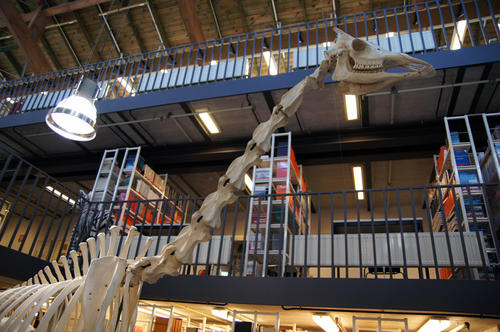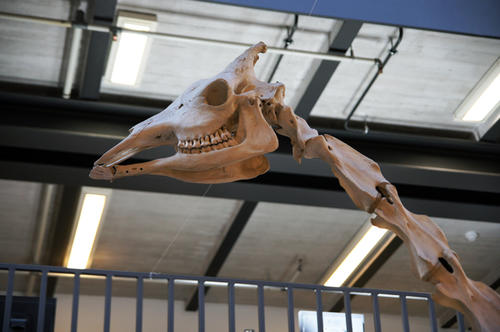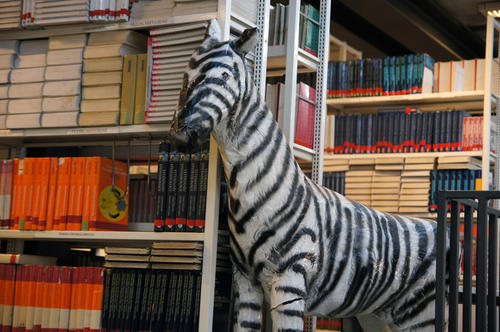Giraffe Rieke & Co.
Skeleton of “Rieke”.
Image Credit: © “Giraffe Skeleton "Rieke" (Veterinary Library, FU Berlin)” by César is licensed under CC-BY-SA 3.0.
Rieke
Our textbook zebra.
For many years “Rieke” has been part of the collection of the Veterinary Library. Rieke is the giraffe skeleton that is looking at the guests entering the journal magazine (ZFM) in the basement. As visitors have repeatedly asked us about this impressive exhibit, Rieke's history can be read here.
We have also made the text available to the free online encyclopedia Wikipedia In the German language edition of Wikipedia, it can be found and freely edited under the lemma “Rieke (Giraffe)”.
Birth and Survival in the Second World War
Rieke (according to other sources “Rike”) was born in October 1938 in the Zoological Garden of Berlin. Her dam ("Anneliese") and her sire were caught in the wild in the Lake Turkana region, in East Africa and were brought to Berlin. The animals were kept in lattice enclosures and systematized as Powell-Cotton-Giraffes, named after the British zoologist and discoverer Major Percy Horace Gordon Powell-Cotton (1866-1940). This subspecies is now considered one of the Ugandan giraffes and is no longer considered an independent species. It is believed to be the most common species of giraffe in zoos.
Rieke grew up with her parents on the premises of the antelope house. During the Second World War, the zoological garden was not spared from air raids. In a severe attack on November 22 and 23,1943, 30 percent of the remaining livestock was killed within 15 minutes. The antelope house, where Rieke and her parents lived as the only remaining giraffes, was also destroyed by explosives and fire bombs. The parents were killed. The five-year-old Rieke was slightly injured in the knee by a bomb shrapnel.
Due to the heavy air raid, which also killed many other large animals, the zoo remained closed until July 25, 1944. After the healing of her injury, Rieke was evacuated to the Schönbrunn Zoo in Vienna on November 15, 1944. Documents from the Schönbrunn Zoo, however, note the entry of a female giraffe from the Berlin Zoological Garden one year earlier, on November 16,1943. The telegram from Berlin, dated November 10,1943, reads as follows: “Giraffe departing Thursday evening from Berlin Zoo”. This animal was however listed as an “exchange” in Vienna.
At the end of April / beginning of May 1945, the Zoological Garden was completely destroyed during the final battles of the war. Of the 900 animals (approx. 325 species) remaining in Berlin on December 31,1944, only 91 animals (45 species) survived the war after the Russian troops withdrew from the zoo on May 23,1945.
Evacuation to Vienna and return to Berlin
Rieke spent the next eight years on Schönbrunn's giraffe complex, which also suffered war damage but still exists today. It was not until 1953 that the animal was to return to Berlin. In 1951 the reconstruction of the Berlin antelope house began. The former fenced enclosures were converted into spacious open-air facilities. After the war, Katharina Heinroth, scientific director of the Zoological Garden since 1945, had met Julius Brachetka, then director of the Schönbrunn Zoo, in the international association of zoo directors. The good relationship between the two contributed to returning the 15-year-old giraffe.
On August 18,1953, Riekes was removed from the Schönbrunn Zoo. The animal arrived a day later at Berlin-Grunewald railway station, where it was received by Katharina Heinroth, in the presence of the press and the Vienna Zoo Director. The giraffe reached the old stable in the antelope house on the same day, in front of which several hundred visitors came. Rieke refused to enter the giraffe enclosure at first. “The animal could not be attracted by the most beautiful delicacies. After her long journey in a crate, she liked the stable much better; perhaps she also remembered the bomb scare she had experienced there in the open-air run”, Heinroth explains in remembrance of the welcoming ceremony in her autobiography, Mit Faltern begann’s (1979).
Rieke was the first giraffe in Berlin's zoo after the end of the war. At the same time, she was the only evacuated animal to be returned. In 1943/44, due to the turmoil of war, about 750 animals in 250 species were evacuated from the Berlin Zoological Garden to the zoos of Breslau, Mulhouse, Munich, Poznan, Prague and Vienna.
New mate and death
The reconstruction of the antelope house continued until 1956. In 1954 Rieke lost weight and had a severe cough. A tuberculosis disease was diagnosed. Wilma von Düring, the first zoo veterinarian after the war, then applied a cure and Rieke gained weight again. After one year without any bacteria, she was given a mate called “August”. The approximately two-year old giraffa camelopardalis reticulata was caught in the wild in Tanganyika and donated to the zoo by the Berlin department store DeFaKa (Deutsches Familien-Kaufhaus GmbH). An animal of the same subspecies was not obtainable. The donation was made in connection with the opening of the DeFaKa branch in Tauentzienstraße, not far from the zoo, at the Kaiser-Wilhelm-Gedächtnis-Kirche.
After the arrival of August on September 22,1955, the behaviour of Rieke changed. The over 16 years old, quiet and thoughtful giraffe mothered the not yet fully grown male and became vigilant and anxious. “Our August began to gallop in a playful way, so she was visibly startled and immediately began racing. She got infected by her companion's tricks”, says Heinroth.
Rieke was never able to cure her lung disease completely, however, and died seriously ill, on February 25, 1957, at the age of 19 years. One day after the death of the giraffe, the West Berlin newspaper Tagesspiegel reported that Rieke undoubtedly has been one of the “most prominent” zoo inhabitants. August (nickname: “August Drahtbeen” [August Wire-Legs]) remained alone. The animal was later traded in for a Massai giraffe bull, while a female animal was again donated by DeFaKa department store. The new pair of giraffes was also christened Rieke and August.
An amusing anecdote about Rieke's section can be found in Heinz-Georg Klös's article Der Tierarzt im Zoo (The Veterinarian at the Zoo), published in 1966, in which the then director of the Berlin Zoological Garden deals, among other things, with the lack of a textbook for zoo-animal medicine and the little knowledge that veterinary students had of zoo animals. “In the nine semesters of his studies, a veterinary student learns how to treat horses and cattle, sheep, goats, pigs, dogs and cats and possibly poultry – and that is something he has a lot to do with. He has no idea of the anatomy of a hippopotamus, a giraffe or a sloth, and understandably he is not able to learn anything during the compulsory lectures. What an understandable shock, when such humble state examination candidate, filled with knowledge about the inner life of pets, comes unaware into the section room and suddenly faces a dead giraffe! This happened in 1957 in Berlin, when the old giraffe Rieke died. Despite the scare it turned out to be a very enjoyable and interesting exam, because the professors were also on new ground."
There is still a blank spot behind the remains of the giraffe skeleton from 1957 until the opening of the Veterinary Library in 1998.


